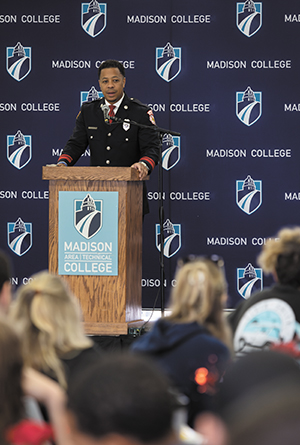Dawn of the Dead Review
May 6, 2021
Ahead of the release of “Army of the Dead,” Zack Snyder’s return to the zombie film genre, I decided to revisit “Dawn of the Dead” (2004), the director’s theatrical film debut. Released in 2004, Zack Snyder’s remake of the George A. Romero genre classic was met with surprisingly good reviews and a strong showing at the box-office.
The film grossed approximately $59 million on a $26 million budget and currently holds a 75% certified fresh rating on rotten tomatoes. Over the years “Dawn of the Dead” (2004) has developed something of a cult following as well as a reputation as perplexing as the divisive author who helped craft it.
Along with the J-horror craze, 2000’s horror was defined by remakes of 70’s and 80’s genre classics. Just one year prior to “Dawn” (2004) the Michael Bay produced remake of “The Texas Chainsaw Massacre” was released, followed four years later by Rob Zombie’s remake of “Halloween.” Like “Dawn” (2004) each of these films were major studio releases featuring recognizable stars and significantly larger budgets than their original counterparts.
All were also criticized for stripping away what made their originals so great. However, unlike “The Texas Chainsaw Massacre” (2003) and “Halloween” (2007), “Dawn” (2004) still managed to garner acclaim from both fans and critics alike. “Dawn” (2004) stars Sarah Polley who just one year earlier won rave reviews for her work in “My Life Without Me” and would go on to direct the documentary, “Stories We Tell.”
The film opens with her working as a nurse in a Milwaukee County hospital. The film’s setting has been moved from the Pittsburg, PA area, where the original Dead Trilogy was famously set, and Romero himself a proud resident of. Wisconsinites however need not blame themselves for failing to recognize Cream City in this film.
Aside from one shot of a Wisconsin flag and passing mention of Miller Park (forever!), there is little evidence that this film is set in Milwaukee. The changing locations was perhaps an inspired personal touch by Snyder, who was born in Green Bay. The film quickly manages to establish an ominous tone. While Polley’s character is leaving work, audiences can hear doctors in the background discussing a patient who is being admitted with a bite injury.
Upon returning home she enjoys a romantic evening with her husband which distracts the two from the emergency broadcast the plays over the television. The film wastes no time throwing audiences into the zombie action. A grand total of about 10 minutes of runtime passes before Polley’s character finds herself awakening to a world in the midst of the zombie apocalypse.
At the time of its release zombie inspired action like this had never before been seen on either the big or small screen. Film and television shows like “World War Z” and “The Walking Dead” were six to nine years away from premiering. Even by today’s standards “Dawn” (2004)’s opening set piece stands out as an expertly crafted, thrilling set piece and a high point in Snyder’s career.
As does the excellent opening credit sequence played out to Johnny Cash’s When the Man Comes Around. During her escape Polley’s character joins up with other survivors played by Ving Rhames, Jake Webber (one year away from his role on Medium), Inna Korobkina and Mekhi Phifer who was still starring on ER. The group soon seek refuge in a shopping mall where they are forced to join forces with a band of overzealous mall cops led by Michael Kelly, best known today for his work on Netflix’s “House of Cards.”
Later they are joined by even more survivors, including Ty Burrell in one of the films more stand out performances. Fans of “Modern Family” will recognize him as the lovable and goofy Phil Dunphy. However, here he plays a sleazy director of adult films and is clearly having the most fun doing so of any of the cast. The film’s mall setting is about the only thing it has in common with the original. Whereas Romero’s original has been hailed as a commentary on American consumerism Snyder’s remake was widely criticized for having little to say about anything. The seeming lack of subtext is the source of derision for the film, but not its greatest controversy.
“Dawn” (2004)’s most controversial decision is in its depiction of the titualar zombies. The film does away with the traditional slow, lumbering living dead and instead features zombies that chase their victims down with speed and ferocity of Za’Darious Smith charging at a quarterback. This decision has inspired countless debates amongst genre fans and was a main point of contention by George A. Romero. Interestingly, “Dawn” (2004) was released just two years after Director Danny Boyle (“Trainspotting,” “Slumdog Millionaire”) and Screenwriter Alex Garland’s (Ex Machina) “28 Days Later….” As with most zombie properties “28 Days Later…” was heavily influenced by the works of Romero, including the original “Dawn of the Dead,” something Garland and Boyle were not shy about. Like “Dawn” (2004) 28 Days Later… has inspired similar controversy regarding its depiction of zombies. In it the zombies are infected with a virus and not dead and are similarly fast.
However, while both films garnered positive reviews, “28 Days Later…” was acclaimed for tapping into the post 9/11 anxieties of the time and for its layered humanist themes. Whereas, “Dawn” (2004) drew praise in lieu of many noting its lack of social commentary. In the hands of Boyle and Garland the fast zombies are the manifestation of societal rage. They are snarling creatures who move in violent, spastic ways with bulging veins and reddened eyes.
Throughout the film we watch our heroes grow closer and increasingly dependent on one another in order to fend them off, while examining the corrosive impact rage has on the world. In “Dawn” (2004) it is hard not to feel at times that the decision to have fast zombies was not made simply because fast zombies are cooler than slow ones.
Menacing as they may be, audiences are frequently invited throughout the film to watch in glee characters do away with them, typically with large firearms. None of this is to suggest that “Dawn” (2004) is a stupid film, or even one with nothing on its mind. “Dawn” (2004) has more guns in it than a war film. It is packed with scenes featuring characters spraying gun fire at charging hordes of zombies, typically shot in low angles with close ups of shells discharging in slow motion.
It would be a stretch to say “Dawn” (2004)’s aim is to act as a commentary on gun culture. It would be just as big a mistake, however, to ignore its attitude towards firearms and other weaponry. The characters in the film are as, if not more, dependent on their weaponry than they are one another in surviving the hordes of flesh-eating dead.
There is even a character named Andy whose entire relationship to other characters is that he likes shooting at zombies from the roof of the gun store he owns. Within the mall the characters of “Dawn” (2004) enjoy a spoil of luxuries, which they use to preoccupy themselves from the horrors occurring outside.
Due to the wealth of supplies the mall provides them, the characters primary focus is on acquiring greater weaponry to fend off a threat that is faster, more resilient and continually outnumbers them. It is in this sense that “Dawn” (2004) fits in nicely with post 9/11 American cinema. It is also here that one finds a thematic reason for making the zombies fast. The credited screenwriter on “Dawn” (2004) is James Gunn who, like Snyder, has a penchant for subverting genre tropes and instilling his films with a sense of nihilism.
Together Snyder and Gunn craft a film that is bathed in cynicism with a foreboding sense of doom running throughout, that makes the zombie apocalypse it depicts all the more effective. It is a popular opinion that “Dawn” (2004) is Zack Snyder’s best movie. Whereas Gunn has gone on to wide acclaim with the “Guardians of the Galaxy” films Snyder’s foray into the DC Extended Universe was as divisive as it was improbable.
There is perhaps no need to recount how an online community united to will his four-hour-cut of Justice League into existence, or the well documented tumultuous journey that preceded it. Each of Snyder’s subsequent films since “Dawn” (2004) have been characterized to varying degrees with their joylessness, self-seriousness and lack of self-awareness.
This has been especially true for films such as “Man of Steel,” “Batman V Superman: Dawn of Justice,” and Zack Snyder’s “Justice League” (did I mention its four-hours long!?). And while these films have garnered as much criticism as they have passionate defenders, most would agree the qualities they lack are “Dawn” (2004)’s true strength. So, as “Army of the Dead’s” May 21 release date approaches, the question is; what version of Zack Snyder will we get?











